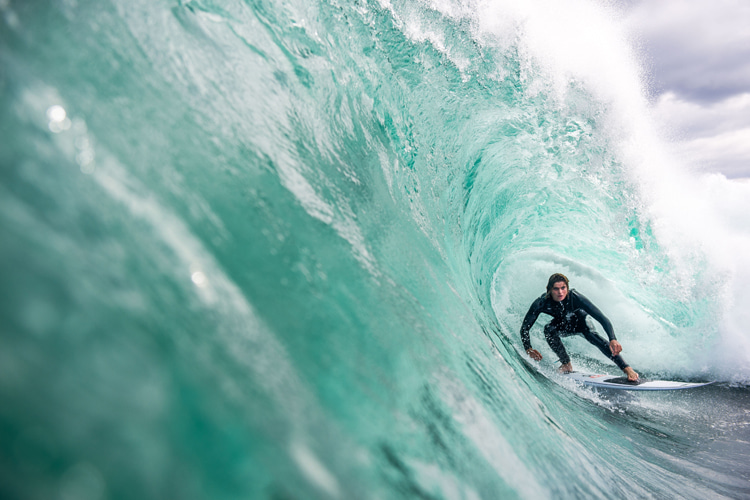The social and economic profile of the Australian surfer

Surfing is one of the most popular sports in Australia. But what is the impact of surfing on the national economy? What is the profile of the average Australian surfer?
Surfing is Australia’s second-most-participated water sport and has profound economic and social impacts on its coastal regions.
Despite its historical significance, there has been limited scholarship quantifying surfing’s contribution to the country’s economy.
However, a study led by Ana Manero, a postdoc research fellow at The Australian National University’s (ANU) Crawford School of Public Policy, estimates that surfing has an impact of A$2.71 billion on the Australian economy per year.
Applying economic multipliers for retail (1.77) and tourism (1.84), the overall annual contribution of surfing to the Australian economy is estimated at A$4.88 billion, split almost equally between retail (A$2.39 billion) and domestic travel (A$2.49 billion).
The research titled “A national assessment of the economic and well-being impacts of recreational surfing in Australia” concluded that the average Australian surfer spends A$1,858 per year on retail and A$1,861 on domestic travel, i.e., A$3,719 yearly.
The analysis considers the following data unveiled by the Australian Sports Commission’s AusPlay survey:
- 727,328 adult Australians (18+ years) practice surfing;
- Surfing is among the top 5 outdoor forms of exercise;
- The number of surfers increased by 46% between 2016 and 2023;
The ANU study also mentions the existence of 1,440 documented surf breaks, of which only 20 are protected in some legal form.
It’s unclear how the author reached this conclusion, given that there are around 12,000 recorded beaches in the country.
It is also unknown how researchers came up with the number of worldwide surfers at 50 million when most sources, including the International Surfing Association (ISA), estimate it between 25 and 35 million.
Last but not least, the sample, although scientifically valid and statistically relevant, could’ve featured a wider audience and not just the 569 responses, given the dramatic differences between the Australian surfing regions and six states.

The Profile of the Australian Surfer
Survey data reveal nuanced spending patterns among surfers.
Expenditure on retail surf-related items and domestic travel varies significantly with factors such as income, age, skill level, and surf frequency.
For instance, highly skilled surfers spend more on both retail items and travel, reflecting their greater engagement with the sport.
Regional differences also emerge, with surfers from Western Australia and Victoria spending more on retail items than New South Wales (NSW).
Most respondents identified as intermediate surfers (41%), with fewer categorizing themselves as having high (advanced or competitive, 22%) or low skill levels (competent, 26%; beginner, 11%).
The most commonly used surfboards were shortboards (53%), followed by longboards (33%).
Surfing is typically practiced twice a week on average.
Over two-thirds of respondents reported regularly surfing with friends (67%) or other acquaintances (6%), including members of social groups like boardriders clubs or “surfing mums.”
Among those living with direct family members, 32% regularly surf with their children, and 28% do so with their spouse.
Survey respondents reported spending an average of A$8.30 on regular items such as food, drinks, or parking each time they visit their usual surf spots.
Based on their reported surfing frequency, the estimated annual expenditure per surfer on these regular items is A$697.
Excluding second-hand surfboards, the average annual expenditure on surf equipment (boards, wetsuits, swimsuits, accessories, etc.) and other items (e.g., car roof racks, board repairs, surf lessons) is A$1,381 per person, with new surfboards accounting for the largest portion (40%).
Most of this expenditure is domestic, with 93% of respondents reporting that 75%-100% of their surf-related spending occurs within Australia.
When accounting for the proportion spent domestically and excluding second-hand boards and travel, the average surfer spends A$1,172 in Australia each year on equipment and other surf-related purchases.
Adding domestic expenditure on regular items results in a total annual retail expenditure of A$1,868 per surfer.
Total expenditure for the last trip, including costs covered by the respondent for others, averaged A$1,480, with accommodation (A$616) and travel (A$382) being the largest components.
Based on the average overnight expenditure from the last trip and the average number of domestic trips per year, the annual travel expenditure for those who took at least one overnight trip was calculated to be A$2,347 per surfer.
Assuming zero expenditure for those who did not travel, the average domestic travel expenditure across the sample was A$1,901.

Skilled Surfers Spend More
Ana Manero and his team also observed a strong positive correlation between household income and spending on surf retail, indicating that for every additional dollar in household income, surf retail expenditure rises by about A$4.23.
Conversely, there is no significant link between household income and spending on domestic travel.
Australian surfers aged 45-54 exhibit a significantly higher expenditure in both models than those aged 65 and older.
The domestic travel model also reveals that surfers under 35 spend less on travel than their older peers.
When other variables are held constant, households with children show significantly higher travel expenditures – A$709 more than those without children – likely due to the higher costs associated with family travel.
Surfers who primarily use shortboards spend an additional A$209 per year on domestic travel compared to those who favor longboards.
The difference may reflect the greater convenience of traveling with smaller and lighter surfboards.
Surfers who consider themselves highly skilled spend an average of A$386 more on retail surf-related items and A$512 more on domestic surf travel compared to intermediate or beginner surfers when controlling for other variables.
The gap likely stems from skilled surfers purchasing higher quality gear and possibly spending more on trips to premium surf destinations.
High skill levels are also associated with increased surfing frequency and more domestic trips, supported by positive and significant correlations.
Surf frequency demonstrates a robust positive correlation with retail expenditure, suggesting that for each additional surfing session per year, surfers spend approximately A$12 more on related items.
This expenditure aligns with costs for essentials like sunscreen and surf wax and the increased need for equipment maintenance, such as wetsuits and boards.
As anticipated, in the travel expenditure model, the number of trips per year and the duration of the last trip significantly correlate with higher spending.
According to the researcher’s model, each additional trip contributes an average of A$133 to total expenditures, while each additional night away adds A$42.
These figures appear conservative compared to typical travel costs within Australia, indicating the estimates likely underestimate actual surf travel expenditures.
Living in Western Australia or Victoria is linked to a notable rise in retail expenditure compared to the reference state of NSW.
In the travel expenditure model, only Victoria emerged as a significant predictor.
These findings hint at potential regional disparities in surfing culture, consumer behaviors, or accessibility to premium surf spots.

The Feel Good Sport
In a survey covering 11 measures of perceived impacts, most participants expressed that their involvement in surfing yielded positive results, such as feeling “better” or “much better.”
The most substantial improvements were noted in physical health (95%), mental health (99%), ability to manage stress and difficulties (94%), and time spent outdoors (96%).
Surfing also emerged as fostering community engagement, with over 80% reporting positive effects on “participation and sense of belonging to a community” and “ability to maintain and enjoy existing relationships.”
While a smaller percentage indicated no change in healthy eating habits (69%) and a reduction in smoking/alcohol consumption (50%), those reporting positive changes may signify a broader lifestyle adjustment linked to their surfing activities.
There was a notable variability in responses regarding surfing’s impact on work productivity: while 61% reported improvement, 6% noted a decline.
These findings suggest that while surfing generally contributes to overall health and well-being, its influence on work productivity may hinge on individual circumstances or workplace dynamics.
The survey findings shed light on how surfing influences the lifestyle choices of participants compared to other considerations.
This is evident in the high importance placed on surfing when making decisions about “where to live,” “where to go on holidays,” and “which car to buy,” with 78%, 70%, and 69% of respondents, respectively, rating surfing as “very or extremely important.”
These responses underscore a strong preference for residing near surf spots and embracing a lifestyle centered around leisure and community, core values within surfing culture.
Moreover, the survey highlighted significant concerns among surfers regarding their engagement with the sport and coastal environments.
Issues such as overcrowding, poor water quality, and climate change/coastal erosion emerged as top concerns, with more than three-quarters of respondents expressing moderate to extreme apprehension about these challenges.
Pressure from coastal developments and housing affordability also ranked high, with nearly two-thirds of respondents sharing these concerns.
In contrast, despite being a recognized risk, the presence of sharks was a major concern for only 31% of respondents.
Words by Luís MP | Founder of SurferToday.com



